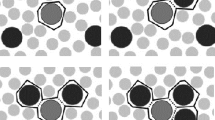Abstract
Aspects of the theory of associate mixtures formed as a result of electrostatic interaction between their components are discussed. We obtained equations, convenient for comparison with the experiment, that elucidate the dependence of the association constant on the dielectric susceptibility of the solvent. The experimental results of the associates studied, which were composed of a diazo-salt cation and an anion of a xanthene dye, are described satisfactorily by the theoretical dependences, but with a smaller equilibrium distance between the associate component. We have shown that the smaller equilibrium distances are due to the fact that the dependence of the dielectric susceptibility of the solvent on the distance ɛ(r) for small distances between the interacting ions is not taken into account in the qualitative theory.
Similar content being viewed by others
Literature cited
H. Been and A. Weller, “Characteristic of nuclear complexes in the excited state,” Acta. Phys. Pol., 34, No. 4, 593–602 (1968).
J. B. Birks, “Excimer fluorescence of aromatic compounds,” Prog. React. Kinet., 5, 181–272 (1970).
N. Orbach, R. Potashnik, and M. Ottofenghi, “Primary processes in excited charge-transfer systems,” Z. Phys. Chem., 76, No. 8, 1133–1139 (1972).
H. Harned and B. Owen, The Physical Chemistry of Electrolytic Solutions, Reinhold, New York (1950).
W. R. Gilkerson, “Application of free volume theory to ion pair dissociation constant,” J. Chem. Phys., 25, No. 6, 1199–1202 (1956).
J. C. Poirier and J. H. De Lap, “On the theory of ion pairs in solutions,” ibid., 35, No. 1, 213–227 (1961).
P. A. Kdndratenko, M. P. Gorishnyi, T. A. Gordina, et al., “Study of the effect of sensitization of the light-sensitivity of diazo compounds with fluorescein,” Spos. Zap. Inf. Bessereb. Nositel., 8, 48–55 (1977).
I. P. Zharkov and P. A. Kondratenko, “Nature of the interaction of diazonium salts with eosin molecules in solutions,” Ukr. Fiz. Zh., 28, No. 6, 861–865 (1983).
Ya. Yu. Akhadov, Dielectric Properties of Binary Solutions [in Russian], Nauka, Moscow (1977).
S. G. Éntelis and R. P. Tiger, Reactions Kinetics in the Liquid Phase [in Russian], Khimiya, Moscow (1973).
Author information
Authors and Affiliations
Additional information
Translated from Teoreticheskaya i Éksperimental'naya Khimiya, Vol. 22, No. 5, pp. 591–596, September–October, 1986.
Rights and permissions
About this article
Cite this article
Kondratenko, P.A. Role of electrostatic interaction in the processes of complex formation. Theor Exp Chem 22, 564–569 (1987). https://doi.org/10.1007/BF00522542
Received:
Revised:
Issue Date:
DOI: https://doi.org/10.1007/BF00522542




